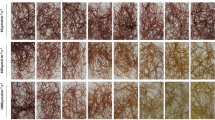Abstract
The effect of sudden salinity increases on the kinetics of growth and carotenogenesis was studied in three geographically diverse isolates of Dunaliella saliva. A sudden increase in salinity results in a lag phase in growth and the length of this lag phase is dependent on the final salinity and the magnitude of the salinity change (no lag at 10–15% w/v NaCl, 4-day lag at 30% NaCl). There is also a lag before an increase in the total carotenoid content can be measured following the salinity up-shock, and the length of the lag depends largely on the initial salinity and the magnitude of the salinity up-shock, whereas the rate of carotenogenesis and the final carotenoid content reached depend on the final salinity. The increase in total carotenoid content is mainly due to β-carotene. Following the salinity up-shock (especially from 10% to 20% NaCl) the proportion of lutein as a percentage of total carotenoids decreases, whereas zeaxanthin increases. This suggests that the pathway synthesising lutein is more sensitive to salt or osmotic stress and is inhibited at higher salinities, thus leading to β-carotene formation. The proportion of α-carotene does not change.
Similar content being viewed by others
References
Aizawa K, Miyachi S (1984) Carbonic anhydrase located on cell surface increases the affinity for inorganic carbon in photosynthesis of Dunaliella tertiolecta. FEBS Lett. 173: 41–44.
Ben-Amotz A (1987) Effect of irradiance and nutrient deficiency on the chemical composition of Dunaliella bardawil Ben-Amotz & Avron (Volvocales, Chlorophyceae). J. Plant Physiol. 131: 479–487.
Ben-Amotz A, Avron M (1982) The potential use of Dunaliella for the production of glycerol, β-carotene and high protein feed. In: San-Pietro A (ed.), Biosaline Research: A Look to the Future. Plenum Publishing Corp., New York: 207–214.
Ben-Amotz A, Avron M (1983) On the factors which determine the massive β-carotene accumulation in the halotolerant alga Dunaliella bardawil. Plant Physiol. 72: 593–597.
Borowitzka LJ (1981) The microflora. Adaptations to life in extremely saline lakes. Hydrobiologia 81: 33–46.
Borowitzka LJ, Borowitzka MA, Moulton TP (1984) The mass culture of Dunaliella salina for fine chemicals: from laboratory to pilot plant. Hydrobiologia 116/117: 115–121.
Borowitzka MA (1988) Algal media and sources of algal cultures. In: Borowitzka MA, Borowitzka LJ (eds), Microalgal Biotechnology. Cambridge University Press, Cambridge: 456–465.
Borowitzka MA, Borowitzka LJ (1988a) Dunaliella. In: Borowitzka MA, Borowitzka LJ (eds), Micro-algal Biotechnology. Cambridge University Press, Cambridge: 27–58.
Borowitzka MA, Borowitzka LJ (1988b) Limits to growth and carotenogenesis in laboratory and large-scale outdoor cultures of Dunaliella salina. In: Stadler T, Mollion J, Verdus MC, Karamanos Y, Morvan H, Christiaen D (eds), Algal Biotechnology. Elsevier Applied Science, London: 371–381.
Brown AD, Borowitzka LJ (1979) Halotolerance of Dunaliella. In: Levandowsky M, Hunter SH (eds), Biochemistry and Physiology of Protozoa, 2nd edn., Vol. 1. Academic Press, New York: 139–190.
Brown AD, Goyal A, Larsen H, Lilley RMcC (1987) A salt-sentitive mutant of Dunaliella tertiolecta. A role of carbonic anhydrase. Arch. Microbiol. 147: 309–314.
Brüggemann M, Weiger C, Gimmler H (1978) Synchronized culture of the halotolerant unicellular green alga Dunaliella parva. Biochem. Physiol. Pflanzen 172: 487–506.
Fosket DE, Radin DN, Guiltinan M (1983) Chemical induction of carotenogenesis and its relationship to chromoplast differentiation in cultured plant tissues. In: Thomson WW, Mudd JB, Gibbs M (eds), Biosynthesis and Function of Plant Lipids. American Society of Plant Physiologists, Rockville: 195–215.
Gimour DJ, Hipkins MF, Boney AD (1982) The effect of salt stress on the primary processes of photosynthesis in Dunaliella tertiolecta. Plant Sci. Lett. 26: 325–330.
Gilmour DJ, Hipkins MF, Boney AD (1984) The effect of osmotic and ionic stress on the primary processes of photosynthesis in Dunaliella tertiolecta. J. exp. Bot. 35: 18–27.
Gimmler H, Wiedeman C, Möller E (1981) The metabolic response of the halotolerant green alga Dunaliella parva to hypertonic shocks. Ber. Deutsch. Bot. Ges. 94: 613–634.
Kessly DS, Brown AD (1981) Salt relations in Dunaliella. Transitional changes in glycerol content and oxygen exchange reactions on water stress. Arch. Microbiol. 129: 154–159.
Loeblich LA (1982) Photosynthesis and pigments influenced by light intensity and salinity in the halophile Dunaliella salina (Chlorophyta). J. Mar. Biol. Ass. U.K. 62: 493–508.
Lowry OH, Rosebrough NJ, Farn AL, Randall RJ (1951) Protein measurement with the folin phenol reagent. J. Biol. Chem. 193: 265–275.
Massyuk NP (1966) Mass culture of the carotene-containing alga Dunaliella salina Teod. Ukransk. Bot. Z. 23: 12–19 (in Ukrainian).
Massyuk NP, Abdula EG (1969) First experiment of growing carotene-containing algae under semi-industrial conditions. Ukransk. Bot. Z. 26: 21–27 (in Ukrainian).
Mil'ko ES (1963) Effect of various environmental factors on pigment production in the alga Dunaliella salina. Mikrobilogyia 32: 299–307.
Moulton TP, Sommer TR, Burford MA, Borowitzka LJ (1987) Competition between Dunaliella species at high salinity. Hydrobiologia 151/152: 107–116.
Sachs MM, Ho TD (1986) Alteration of gene expression during environmental stress in plants. Ann. Rev. Plant Physiol. 37: 363–376.
Sadka A, Lers A, Zamir A, Avron M (1989) A critical examination of the role of de novo protein synthesis in the osmotic adaptation of the halotolerant alga Dunaliella. FEBS Lett. 244: 93–98.
Sass E, Ben-Yaakov S (1977) The carbonate system in hypersaline solutions: Dead Sea brines. Mar. Chem. 5: 183–199.
Semenenko VE, Abdullayev AA (1980) Parametric control of β-carotene biosynthesis in Dunaliella salina cells under conditions of intensive cultivation. Fiz. Rast. 27: 31–41 (in Russian).
Thomson WW, Whatley JM (1980) Development of nongreen plastids. Ann. Rev. Plant Physiol. 31: 375–394.
Williams RJH, Britton G, Goodwin TW (1967) The biosynthesis of cyclic carotenes. Biochem. J. 105: 99–106.
Author information
Authors and Affiliations
Rights and permissions
About this article
Cite this article
Borowitzka, M.A., Borowitzka, L.J. & Kessly, D. Effects of salinity increase on carotenoid accumulation in the green alga Dunaliella salina . J Appl Phycol 2, 111–119 (1990). https://doi.org/10.1007/BF00023372
Received:
Revised:
Accepted:
Issue Date:
DOI: https://doi.org/10.1007/BF00023372




